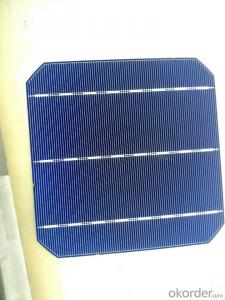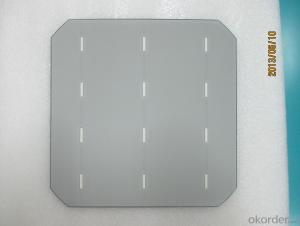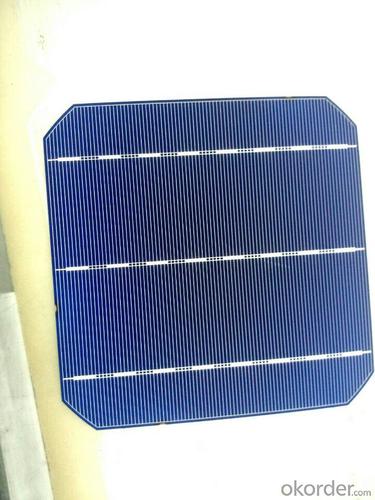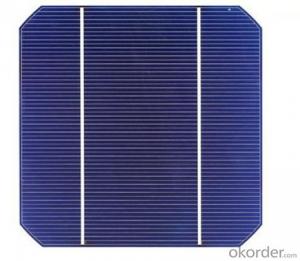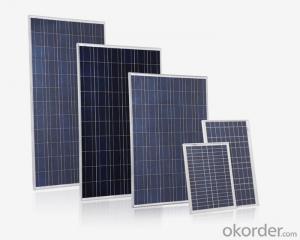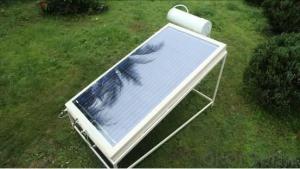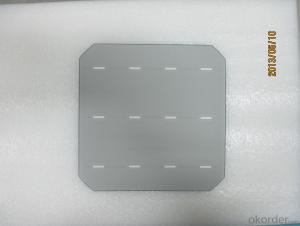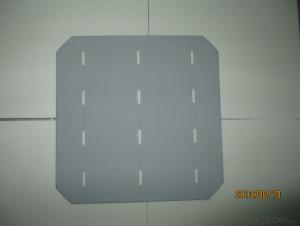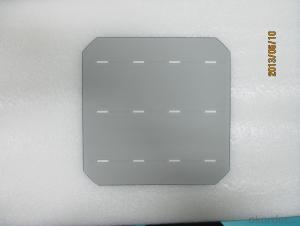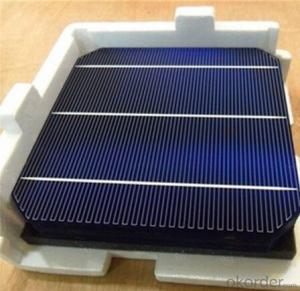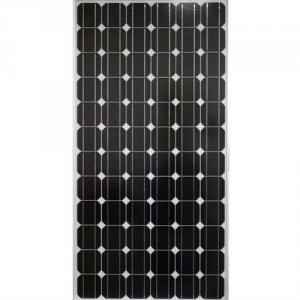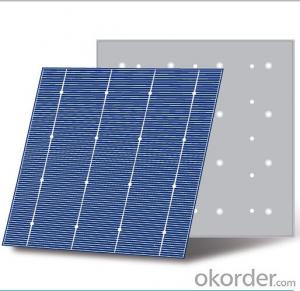Solar Cells 6x6 Mono 156*156mm Monocrystal Solar Cell with 4.67 Watt High Efficiency
- Loading Port:
- Shanghai
- Payment Terms:
- TT or LC
- Min Order Qty:
- 1000 pc
- Supply Capability:
- 20000000 pc/month
OKorder Service Pledge
OKorder Financial Service
You Might Also Like
Brief Introduction of Solar Cells
A solar cell, is an electrical device that converts the energy of light directly into electricity by the photovoltaic effect, which is a physical and chemical phenomenon. It is a form of photoelectric cell, defined as a device whose electrical characteristics, such as current, voltage, or resistance, vary when exposed to light. Solar cells are the building blocks of photovoltaic modules, otherwise known as solar panels
Monocrystal solar energy cell
Type:156M
Appearance:156×1565㎜±0.5mm; Diagonal:R=100mm
Main fence wide:1.4-1.5mm Back electrode wide:2-2.5mm
Fence line qty:90
Cell thickness:220um±20um
Eff(%) | 19.1- 19.2 | |||||||||||
Pm(W) | 4.56 | |||||||||||
Isc(A) | 8.93 | |||||||||||
Im(A) | 8.51 | |||||||||||
Voc(V) | 0.64 | |||||||||||
Vm(V) | 0.538 | |||||||||||
FF(%) | 80 |

remark:our company cells as per working current concentrate principle,separate the first and the second grade
Applications of Polycrystalline Solar Cells
Assemblies of photovoltaic cells are used to make solar modules which generate electrical power from sunlight, as distinguished from a "solar module" or "solar panel". A solar array generates solar power using solar energy.
Factory Picture of Solar Cells
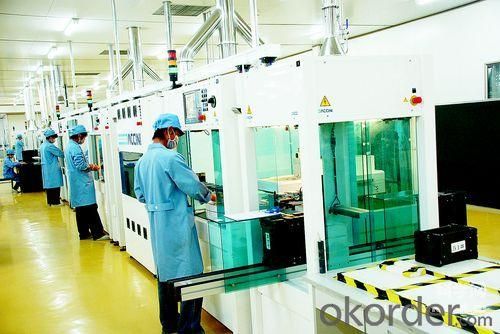
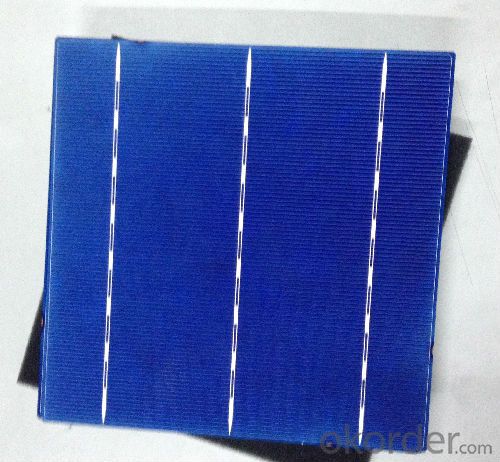
FAQ
We have organized several common questions for our clients,may help you sincerely:
What’s price per watt?
A: It’s depends on the quantity, delivery date and payment terms of the order. We can talk further about the detail price issue. Our products is high quality with lower price level.
Can you tell me the parameter of your solar cells?
We have different series of cells with different power output, both from c-si to a-si. Please take our specification sheet for your reference.
How do you pack your products?
We have rich experience on how to pack the panels to make sure the safety on shipment when it arrives at the destination.
Can you do OEM for us?
Yes, we can.
How long can we receive the product after purchase?
In the purchase of product within three working days, We will arrange the factory delivery as soon as possible. The perfect time of receiving is related to the state and position of customers. Commonly 7 to 10 working days can be served
How Much Do Solar Panels Cost On My Roof?
When you ask, “How much do solar panels cost?,” what I think you really want to know is how much it costs to put solar panels on your roof, right?
The bulk of the price of going solar is now the “soft costs” (installation, permitting, etc.) rather than the solar panel cost. Referencing the latest US Solar Market Insight report, the average installed cost of a residential solar panel system is approximately $3.50/watt. (For commercial rooftops, it’s approximately $2.00/watt.)
However, prices vary tremendously by region. “Common residential system prices ranged from less than $3.00/W to just above $7.00/W,” the Solar Energy Industries Association wrote in 2014 regarding 2013 figures. The story hasn’t changed much since then, even though prices on both ends have come down.
The total price of a system, of course, varies tremendously based on the size of your roof and your electricity needs as well.
So, the key is really just to get an initial quote and then get a closer look at your situation from a local installer, who can give you a more specific quote.
Decrease the cost of solar cells
Reduce the silicon material production cost will be the most important measure. At present, under the condition of the high price of silicon, silicon material accounted for 70% ~ 80% of the cost, it is the reason about that. Control the cost of the battery production, Reduce consumption equals reduce cost, silicon material shortage bring a deadly blow to the industry, at the same time, also promote technological progress. Thinned wafers is a very important measure for any country to reduce cost or to improve the efficiency. Then, improve the efficiency of the battery .However, the speed of Battery efficiency increases depend on the quality of process equipment, pursuit of efficiency will make the cost increase a lot. As a business perspective, improve the efficiency of battery and cost of equipment should maintain a balance.
Develops equipment potential will be the another choice. We should vigorously carry out technological innovation, develop the high effectively ways on reduce the cost and improve the conversion efficiency of new technology, new material. At the same time we should pay attention to the integration technologies, the development of large-scale production line, to make solar cells more competitive.
- Q: How do solar cells impact water resources?
- Solar cells have a positive impact on water resources as they do not require water for their operation, unlike traditional power plants that heavily rely on water for cooling purposes. This reduces the strain on water resources and helps in conserving them for other essential needs.
- Q: What is the future of solar cell technology?
- The future of solar cell technology is promising, with advancements focusing on increasing efficiency, reducing costs, and improving durability. Innovations such as perovskite solar cells, tandem solar cells, and flexible solar panels are being developed to enhance performance and expand application possibilities. Additionally, the integration of solar cells into everyday objects and the development of solar-powered devices are expected to further drive the growth and adoption of this renewable energy source. Overall, the future of solar cell technology looks bright, offering potential solutions to our energy needs and contributing to a sustainable future.
- Q: Can solar cells be used to power an entire household?
- Yes, solar cells can be used to power an entire household. By installing a sufficient number of solar panels and utilizing battery storage systems, solar cells can generate enough electricity to meet the energy needs of a household. This allows for the reduction or elimination of reliance on the traditional electrical grid, resulting in lower energy costs and a more sustainable and environmentally friendly power source.
- Q: What are the environmental impacts of solar cell production?
- The environmental impacts of solar cell production include the extraction of raw materials, such as silicon, which can contribute to deforestation and habitat destruction. The manufacturing process also requires a significant amount of energy, which may be sourced from fossil fuels and contribute to greenhouse gas emissions. Additionally, the disposal and recycling of solar panels can pose challenges, as some components contain harmful substances. However, it is important to note that the overall environmental benefits of solar energy, such as reduced greenhouse gas emissions and reliance on fossil fuels, outweigh these impacts.
- Q: Can solar cells be used for powering water pumps?
- Yes, solar cells can be used for powering water pumps. Solar cells convert sunlight into electricity, which can then be used to power various devices, including water pumps. This is a sustainable and efficient solution, particularly in areas with ample sunlight, where it eliminates the need for traditional energy sources or expensive infrastructure for electrical connections.
- Q: What is the role of silicon in solar cells?
- The role of silicon in solar cells is to act as a semiconductor material that can absorb sunlight and convert it into electricity through the photovoltaic effect. Silicon is the most commonly used material in solar cell manufacturing due to its abundance, stability, and ability to efficiently convert sunlight into electricity. It forms the basis of the p-n junction, which allows for the separation and movement of electrons and holes, generating an electric current.
- Q: How to generate solar cells, the principle of PN junction
- The production of solar cells is mainly based on semiconductor materials, its working principle is the use of photoelectric materials to absorb light energy after the photoelectricity in the conversion reaction, according to the different materials used, solar cells can be divided into: 1, silicon solar cells;
- Q: How do solar cells impact the local economy?
- Solar cells have a positive impact on the local economy as they create jobs, stimulate investment, and reduce energy costs. The installation, maintenance, and manufacturing of solar cells require skilled labor, thus creating employment opportunities within the community. Additionally, the growth of the solar industry attracts investments in infrastructure and research, fostering economic development. Moreover, solar energy helps lower electricity bills for businesses and households, freeing up funds that can be spent on other local goods and services, thereby boosting economic activity.
- Q: How do solar cells perform in areas with frequent hurricanes?
- Solar cells can perform well in areas with frequent hurricanes, provided they are properly installed and designed to withstand high winds. It is important to use durable materials and secure mounting systems to ensure their stability during extreme weather events. Additionally, incorporating protective measures such as storm shutters or reinforced frames can help safeguard the solar panels during hurricanes.
- Q: Solar cells and the difference between ordinary batteries. Why is the solar cell is converted into electrical energy, zinc battery is what is converted into chemical energy
- The so-called chemical energy, in fact, is "chemical potential". Can be released through the oxidation-reduction reaction of energy, into other energy. This is the release of chemical energy.
Send your message to us
Solar Cells 6x6 Mono 156*156mm Monocrystal Solar Cell with 4.67 Watt High Efficiency
- Loading Port:
- Shanghai
- Payment Terms:
- TT or LC
- Min Order Qty:
- 1000 pc
- Supply Capability:
- 20000000 pc/month
OKorder Service Pledge
OKorder Financial Service
Similar products
Hot products
Hot Searches
Related keywords
